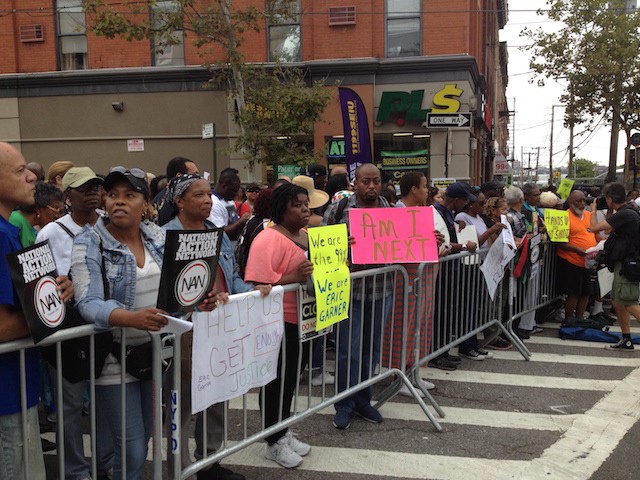A Rally for the Dead
by Brendan O’Connor

“How many times must we drink from the bitter cup of injustice?” Bishop Victor Brown asked at the “We Will Not Go Back” march on Saturday, which began in Staten Island where Eric Garner, a forty-three-year-old husband and father of six, died a little over a month ago after being placed in a chokehold, by officer Daniel Pantaleo. “We will not engage in the luxury of ‘cooling off’ or the tranquilizing drug of gradualism.”
The demonstration — organized by Al Sharpton’s National Action Network — was intended to pressure federal prosecutors to step in and investigate the death as a civil rights case. As complicated as police brutality cases are, bringing such cases to trial — much less attaining a conviction — in a place like Staten Island, where so many have family members who work in law enforcement, is a challenge.
“We need the Feds to come in right now,” Constance Malcolm, the mother of Ramarley Graham, an unarmed eighteen-year-old who was shot by the NYPD in February 2012, said while addressing the crowd. “We need accountability.” She was joined by Kadiatou Diallo, the mother of Amadou Diallo, an unarmed twenty-two-year-old who was shot by the NYPD in February 1999. “Too much pain, too much struggle. Too many tears, too many victims,” Diallo said. “This has got to stop, and we will be here until it does.” Graham was five years old when Diallo was killed; Ferguson’s Michael Brown was three.
Fences separated those on the sidewalk, mostly media and other spectators, from those in the street. “They still got us caged,” one woman said, shaking the fence. Many of the several thousand who marched carried signs — some homemade, some provided by the organizers. Some read “Unarmed Civilian” and were taped to demonstrators’ chests or backs. “No justice, no peace! No killer police!” the crowd chanted as a prominent but placid NYPD presence looked on from both inside and outside the fences. “Hands up!” someone would shout. “Don’t shoot!” others would respond, invoking Michael Brown.
A diversity of political inclinations was represented in the several-thousand person-strong crowd. “America needs a socialist revolution,” someone muttered. “The police cannot be reformed,” shouted someone else, handing out copies of the Challenge, a communist newspaper. “The state cannot be reformed.” A white reporter took a selfie with the crowd in the background; a black man selling Pan-African flags photobombed him. Some members of the press mobbed Zephyr Teachout, who is campaigning for the Democratic nomination in the New York gubernatorial election.
The march passed by the district attorney’s office and ended down by the water, where the speakers onstage focused on the necessity of prosecuting the offending officer to the fullest extent of the law. The message, everyone insisted, was not anti-cop, but anti-bad cop. “A crime has been committed,” Dr. Hazel Dukes, NAACP chapter president for the state of New York, said. “We must punish those who commit crimes.” Daniel Donovan, the Staten Island district attorney, will impanel a grand jury to hear all of the evidence gathered by prosecutors and to determine whether Pantaleo will be charged in Garner’s death, which has been ruled a homicide. Pantaleo — who was also the subject of a civil rights lawsuit in 2012 for allegedly publicly strip-searching a man in his custody — has been stripped of his gun and badge.
“Most police do they jobs,” Sharpton said, before comparing a bad cop to a bad apple: if you don’t remove the bad apple, the good apples will be ruined. “We come to do the NYPD a favor.” He thanked Ramsey Orta, who was onstage but did not speak, for recording the video of Pantaleo putting Garner in the chokehold — a maneuver banned by the NYPD more than twenty years ago. (Orta had recently made bail on a gun charge; he testified before a grand jury that he was being framed as revenge.)
As a light rain started to fall, Sharpton remembered the demonstrations he led in the weeks and months after Yusuf Hawkins was murdered by a white mob in Brooklyn’s Bensonhurst neighborhood twenty-five years ago. Locals hurled watermelons, bananas, and “the n-word” at Sharpton and the demonstrators. None of that, however, happened, on Saturday — a fact for which Sharpton, who was stabbed during one of those Bensonhurst marches, was grateful. “We come a long way,” he said, “which gives us strength to finish the journey.”
Brendan O’Connor is a reporter living off the L train.
